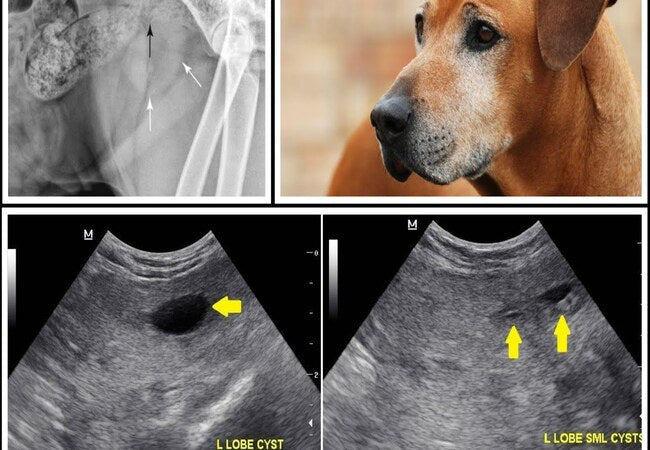🩺 Vet’s 2025 Guide to Canine Prostatic Enlargement in Dogs (BPH & Related Conditions) 🧬

In this article
Vet’s 2025 Guide to Canine Prostatic Enlargement (BPH, Infection & Cysts) 🐾
By Dr. Duncan Houston BVSc
💡 Introduction
Prostatic enlargement in dogs—often >5 years and intact—is most commonly due to benign prostatic hyperplasia (BPH). Other causes include bacterial prostatitis, paraprostatic cysts, and rarely prostatic neoplasia. While some conditions are painless, clinical signs may include hematuria, painful straining, constipation, and even infection.
1. BPH: What Is It & Who's Affected?
- BPH is non‑cancerous enlargement influenced by declining testosterone: estrogen ratio.
- Incidence rises with age—up to 80% of intact males >5 years show changes.
- Clinical signs appear in some: hematuria, hemospermia, preputial discharge, straining during elimination, and infertility.
2. Other Causes of Enlargement
- Bacterial prostatitis: often secondary to BPH; may be asymptomatic or severe—fever, pain, urinary signs.
- Cysts or abscesses: fluid pockets; may cause mass effects—treated by drainage or surgical removal.
- Neoplasia: rare, aggressive prostate cancer seen in neutered dogs, presenting similarly but with metastatic risk.
3. Key Clinical Signs to Watch ⚠️
- Blood in urine or penile/preputial discharge.
- Straining to urinate or defecate; ribbon-like stools.
- Fever, lethargy and possible pain (especially with prostatitis or abscess).
- Infertility or changes in semen quality.
4. Diagnostic Approach in 2025 🧪
- History & exam: rectal palpation—symmetry, size, pain.
- Ultrasound: evaluates prostate size, symmetry, cysts, abscesses—see images above.
- Lab work: CBC, biochemistry, urinalysis with culture to detect infection or inflammation.
- Prostatic fluid/massage cytology: helps differentiate BPH from prostatitis or neoplasia.
- Biopsy: definitive for neoplasia; typically reserved for suspicious cases.
5. Treatment Options ❤️
5.1 Castration (Gold Standard)
- Removes androgen stimulus—prostate shrinks by ~50% in 3 weeks, often resolving symptoms.
- Best for non‑breeding males; reduces both BPH and risk of infection.
5.2 Medical Management for Breeding or Surgical Refusal
- Finasteride: 0.1–1 mg/kg PO daily; reduces prostate volume 40–70% in 16 weeks, maintains fertility.
- Osaterone acetate: antiandrogen tablets giving up to 6-month remission after one course; monitor liver enzymes.
- Deslorelin implant: reversible GnRH agonist; suppresses testosterone but temporarily reduces fertility.
5.3 Treating Infection or Cysts
- Antibiotics: fluoroquinolones, trimethoprim-sulfamethoxazole, erythromycin for 4–6 weeks.
- Drainage or surgery: for abscesses or large cysts; surgical removal for paraprostatic cysts.
- Supportive care: NSAIDs, stool softeners, bladder management as needed.
6. Monitoring & Prognosis
- Post‑castration: recheck rectal and ultrasound in 1–3 months.
- Medical therapy: monthly checks, liver tests if using osaterone.
- Infections: confirm resolution with follow-up cultures.
- Neoplasia: prognosis poor—refer to oncology; median survival ~7 months with intervention.
7. Home Care & Ask A Vet Support 🏡
- Track urination patterns, straining, hematuria via app logs.
- Reminders for neuter, medication doses, antibiotic courses, follow-up imaging.
- Upload photos of discharge or swelling around the prepuce.
- Symptom alerts for fever, appetite loss, constipation, or pain.
- Support guides for owners: after-care for neuter, catheter care, and pain management.
🔍 Key Takeaways
- BPH is common in intact older dogs; castration offers quick and effective resolution.
- Medical options preserve fertility but require close monitoring.
- Infection and cysts complicate presentations—need targeted treatments.
- Ultrasound and cytology are key to accurate diagnosis.
- Ask A Vet provides structured at-home monitoring, medication adherence, and alert systems.
🩺 Conclusion ❤️
In 2025, prostatic enlargement in dogs is best managed with accurate diagnosis and tailored treatment—castration for lasting resolution, or medical protocols for breeding dogs, with infection and cysts requiring focused interventions. Ongoing home monitoring with Ask A Vet helps detect complications early and supports optimal recovery. 🐶✨
Dr Duncan Houston BVSc – combining reproductive expertise with owner-friendly guidance and digital follow‑through.
Visit AskAVet.com and download the Ask A Vet app to log urinary signs, medication reminders, post‑castration support, and reproductive fertility planning from anywhere. ❤️






